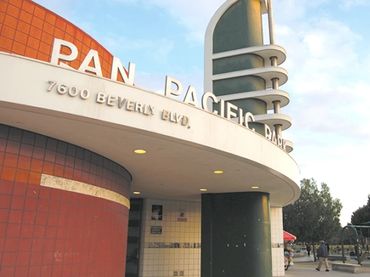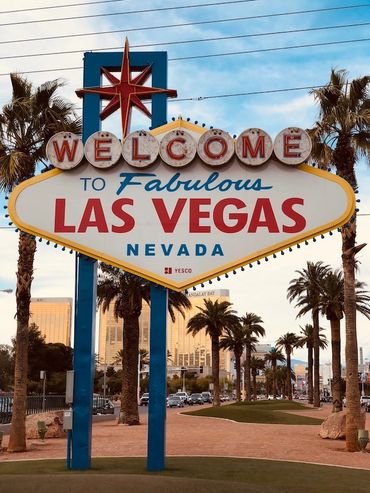Signed in as:
filler@godaddy.com
Signed in as:
filler@godaddy.com
The area begins to look like a grainy black-and-white movie. The audience is presumably inside a silent film in a land that resembles 1920s Hollywood. A crew is on location filming a Charlie Chaplin-style movie, allowing visitors to participate as extras. SAMANTHA, the assistant director, ushers the new participants to the location of the next shot. She explains their motivation for the scene, snaps the clapperboard shut, and director J.B. TUTTLEBAUM yells, "Action."
Classic buildings serve as motifs, including Schwab's Pharmacy, the historic Max Factor structure, Ciro's, Le Dome, and the glitz of old Hollywood. Paths in the theme park show the silent era through 1930s Streamline Moderne, then 1945 to the early 1970s Googie Architecture, as colors gradually weave into the background. They arrive in a movie studio and travel past a John Wayne western, an Esther Williams-style water ballet, and a lavish musical on the backlot, with the director on a camera crane.








After passing sound stages, winding down Colonial Street, and traversing different sets, there's a secret warehouse filled with old movie props.
Each prop stored here was imbued with magical powers by PERCY McNUTIA, a wannabe wizard and prop maker, a persnickety man obsessed with details. His effort to be authentic went awry, and these props were banned and hidden in this warehouse on the outskirts of the studio.
The actors include volunteer audience members transported into iconic films as they act out a scene with enchanted props. Set pieces slide in, backdrops fly in, and projections from the movie encompass them.
Exhilarated that someone has finally discovered this clandestine storeroom, CHECKMATE, the featured chess clock in Searching for Bobby Fischer, befriends the audience. He tags along as their companion to ensure their safe return.
On Nowhere Lane, travelers come from the rear of a facade to the front of a superficial hotel. They push through a revolving door and enter what should have been the other side.
Instead, guests walk through a dusty foyer and into an abandoned hotel lobby. At the end of the hall, mysteriously, doors open to an elevator. The riders are seated in a layout similar to that of The Twilight Zone Tower of Terror™/Guardians of the Galaxy. The doors close from top to bottom (as if it were the blink of an eye), and the elevator takes off like a rocket.
ELLIE, the MAGIC ELEVATOR, is a cheerful woman who is a history buff and clings to the past. She takes the riders on a turbulent passage to one-time Hollywood. Like the elevator in Willy Wonka and the Chocolate Factory, Ellie goes Around the World in 80 days seconds. Then, she backs up into the Hollywood 1950s after the silent movie era and races down Sunset Boulevard.
Enter JOE GILLIS, who convinces Ellie to move on to the present time. She tentatively wavers and chugs along, but then lurches to the next level. On each level, the elevator stops will progress in time and be in the chases of the ages: Bullitt (1968), The French Connection (1971), The Man with the Golden Gun (1974), Smokey & The Bandit (1977), The Blues Brothers (1980), The Italian Job (2003), until the highest level segues into the style of Back to the Future: The Ride/ The Simpsons Ride and we're in the middle of Top Gun.
At the ride's entrance, guests can choose between an extreme and a mild ride option. Next to the elevator is an escalator that leads to a smoother visual journey. It places the rider in classic TV shows, including I Love Lucy, where they are absorbed into the TV and zapped from channel to channel.
The Land, Brace Yourself, Launch Me!
WGAw registration: 2249601
Each unit brings an animated movie franchise to life. The tie-in is a sweeping cinematic approach to the music composition. For example, John Williams' Superman March has a driving rhythmic energy, with smooth, lilting passages, such as "Can You Read My Mind," drifting by in a dream-like state. Even though the cadence varies, the violin orchestrations remain consistent across the transitions, forming a fundamental connection throughout the piece.
For the Reel Magic parade, the passages are themed after our movies. Sooner or later, every section gets a melody unique to its film, although the music stays on the same track throughout the performance.
Choreographically, an unshakable march with innovative dance unifies the parade, demonstrating the striving for excellence that the characters convey in the film they represent. When their special moment floats through the music, the featured routine becomes a focal point as the others turn toward them in reverence. Since the audience is already facing the parade, subtly, it will add a feeling of inclusion and interaction.
WGAw registration: 2250981
Terry John Barto is an award-winning author and screenwriter of Nickerbacher. His story is being adapted into an animated feature film at Arx Anima, an international studio with locations in Vienna, Frankfurt, Leipzig, and Madrid.
He is an accomplished creative director and show director with a track record of professional results. AEA, SAG-AFTRA, SDC

Copyright © 2026 — Figure Nation — All Rights Reserved
We use cookies to analyze website traffic and optimize your website experience. By accepting our use of cookies, your data will be aggregated with all other user data.